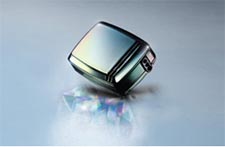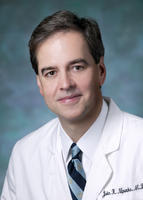Interview with John K. Niparko, M.D., Director, Division of Otology, Audiology, Neurotology, and Skull Base Surgery, Johns Hopkins; President, American Otological Society

John K. Niparko, MD
Carolyn Smaka: Today I am speaking with Dr. John Niparko about the Cochlear™ Baha® BP100. Dr. Niparko, thank you for your time today.
Dr. John Niparko: Good morning, thank you.
Smaka: Dr. Niparko, would you please tell our readers about your background?
Niparko: Sure. I'm from Michigan, and I attended the University of Michigan for all of my professional training, including medical school and specialty and sub-specialty training in otolaryngology. I now direct the Division of Otology and Neurotology at Johns Hopkins. We're involved with a range of technology from conventional hearing aids to several implantable systems, including the Baha and cochlear implants. We also provide a wide range of ongoing auditory rehabilitation services. Our hope is that our patients can develop the ability to take full advantage of the technology we have to offer in this exciting age of technological innovation in hearing care.
I am a member of the Cochlear Corporation's Advisory Board, provide similar board advisement to Advanced Bionics, and I am a non-paid consultant with the Med El Corporation. I provide these consultations without reimbursement. My travel costs are covered but I receive no remuneration for this consulting.
Smaka: Thank you. Let's start with some basic information about Baha. Who are the current candidates, and have the indications for candidacy changed over the years?
Niparko: The traditional indications for a bone anchored device like the Baha are similar to those for patients who would benefit from a traditional hearing aid or a traditional bone conduction transducer. The difference with Baha is that the patient has a condition that makes him or her unable to use a conventional device. The possible conditions include: patients with chronic ear infections, atresia of the ear canal, a patient who developed otitis externa with the use of traditional earmolds, and even patients who have nasopharyngeal carcinomas that require extensive radiation which lowers the patient's tolerance of an earmold within the ear canal. These patients traditionally have a conductive or mixed hearing loss, with bone conduction thresholds no greater than 35 to 45 dB HL and speech discrimination scores of 60% or better.
When evaluating patients with sensorineural hearing loss, candidates typically have a profound loss in one ear and bone conduction thresholds in the opposite ear not exceeding 35-45 dB HL. As you know, this is often referred to as single sided deafness (SSD). This type of patient benefits from the placement of an osseointegrated implant on the side of the deaf ear in order to access the soundfield on that side. The bone anchored device picks up the soundfield on that side and brings that information into the skull base using the Baha processor and the Baha implant. The sound is then transmitted via bone conduction to the better hearing ear, and can be utilized by the patient. Previously, the only technology available to these patients was CROS or BiCROS hearing aids.
Smaka: How are patients who were fit with the early bone anchored devices doing today? Once they have the implant, are they limited to their original processor?
Niparko: Fortunately, this semi-implantable technology can be easily updated. The titanium implant is the only portion that is placed into the skull via surgery. In many cases, we can change the connector that attaches to the implant, called the abutment, in the clinic and without additional surgery. This allows us to easily place a new abutment as needed to accommodate any difference in the processors that may occur with each generation, without the requirement of surgery. The result is that many patients who have used these devices for 20 or even 30 years have been able to enjoy each advance in technology without having a new surgery for each advance. Patients now who will be looking to upgrade to the new BP100, will only be upgrading the processor portion of the device. There is complete backwards compatibility, meaning that the new processor will work with the existing abutment.
Smaka: How is the BP100 different from previous processors?
Niparko: I have yet to use it on a clinical basis, but we have conducted demos on some devices using the software and it's quite impressive. The new processor offers a wide range of programs that allow for much more flexibility and greater potential benefit. From my experience with bone anchored devices, I feel that the BP100's added dimension of programmability is going to be the most exciting feature for professionals and patients. The BP100 can be programmed, unlike prior generations of bone anchored device processors, and thus can be better customized to the individual user's needs.
One of the innovations that is a part of this new programmability and is going to prove to be very useful is what Cochlear is calling Bone Conduction Direct or BC Direct. BC Direct allows the audiologist to directly activate the processor to assess the patient's thresholds and dynamic ranges with a direct behavioral measurement based on the activation of the bone conductor within the processor. This will allow for a more precise fitting than was ever possible before because until now, we weren't able to accurately judge the perceptual experience.
As you know, there is a range of dimensions to sound, and listening is a very subjective experience. I think most people involved in hearing care like to have as many parameters of hearing technology under their control as possible, in order to optimally fit the amplification to the individual's listening needs. What we're seeing now with the Cochlear Baha BP100, is the ability to change not only the loudness or the intensity of the inputs, but also to have some control over the spectral components of sound as well. On a very basic level, frequency output is an example of the kind of things we can adjust for the sophisticated listener, but the programmability that comes with the BP100 also has the potential to aid patients in more difficult situations, such as in noise and when listening to music. Noise and music in particular are two areas of listening where I believe added programmability in the BP100 can have a significant positive impact for patients. Directionality, noise reduction, quality of the sound of the patient's voice, and many more parameters, can be adjusted now with the BP100. The goal is to now develop paradigms for total performance enhancement.
In a way, programming the Baha BP100 with BC Direct is similar to the way cochlear implants and conventional hearing aids are programmed. Thanks to its programmability, we can now program the Baha BP100 similar to in-situ fittings possible in other programmable devices. How that exactly translates to audibility and quality of sound in everyday listening is still being understood, but at least we now have the tools to adjust parameters that can have significant implications in real-world situations.
Smaka: So we should look forward to new best practice fitting protocols in the future?
Niparko: Absolutely, especially since we're seeing growing professional and research interest in the applications of bone conduction. Just as cochlear implants and semi-implantable devices have taught us more and more about cochlear function, my prediction would be that having this increased level of flexibility and programmability in a bone conduction system is going to generate even more interest in the ability to use bone conduction to rehabilitate our patients. We believe we know all of the candidates for bone conduction processors right now in 2009, but in the next five or six years we may find new applications that we had never thought of before.
Smaka: Looking to the future with implantable technology - what kinds of applications are foreseeable?
Niparko: One thing that I think has spurred some of that interest is the observation that our group and others have published on the relatively greater patient satisfaction that we see with implantable systems like the bone anchored device in SSD. We've had CROS technology available to us for several decades, but indications from our patient surveys is that acceptance of CROS systems for SSD is relatively low. Conversely, we have found that most patients with SSD, when motivated and willing to accept and work with the implant and processor, placed behind the ear can find tremendous listening advantages using a bone anchored device like the Baha.
Smaka: In the old days of fitting hearing aids, the thinking was that if a patient had one ear with normal hearing, they were essentially fine. What kinds of problems are people with SSD having?
Niparko: In an era when digital technology is so easily applied to hearing loss, it seems that more and more listeners are looking for solutions to problems like SSD which largely went unmanaged in the past, as you mention. In the case of SSD, the problem is not only a loss of audibility, but the inability localize sound, develop directional hearing skills, and to pull out salient speech cues in noise-challenged situations. Some of those problems are easily and effectively addressed by bone anchored devices, and others are still quite a challenge. However, the BP100 provides us with some new tools to begin to address these more difficult issues. Difficulties, such as understanding speech in noise, can now be addressed with a higher level of sophistication than ever before.
Smaka: Is there a general success rate with the Baha? Is there an issue with patients getting the Baha and discontinuing its use, like people who have "in-the-drawer" hearing aids?
Niparko: This highlights a continuing issue with assessing candidacy. We know with our current demonstration techniques consisting of relatively short listening experiences of just trying out a Baha processor attached to a headband, that patient satisfaction counts for a whole lot. We have found that we can predict long term utilization of the Baha with about 90-95% accuracy. We usually see about 8% of patients discontinue use of the implant due to lack of satisfaction. In addition, there is another approximately 5% of patients who will have a significant physical problem with the implant that will lead to at least a temporary suspension of their use of the technology. Those are risks that we see as small and manageable, that are continually being managed by the clinical community. As we learn more and more about programming these devices, and as the programming becomes more flexible, I think we're going to be able to help solve these problems of patient satisfaction, and to refine our candidacy process. Hopefully we can get utilization rate up to the 99th percentile.
Smaka: Do you think there is the issue of underutilization of Baha, as we know there is with cochlear implants? That is, that there may be many more people who are candidates for the technology but have received misinformation or no information about it, for one reason or another?
Niparko: I think it takes time, understanding, and public awareness to begin to utilize the technology and to identify good candidates. We know there is a general reluctance to having a percutaneous implant;but that implant is small, behind the ear, and therefore it is by and large well camouflaged from the front and cosmetically acceptable. We're finding that cosmetics is becoming less and less a barrier to using this kind of technology. I think the biggest barrier has to do with lack of information and understanding, on the part of both the professional and the patient, of what might be achieved with direct auditory input through the temporal bone. Education is needed so that all parties involved can truly learn to appreciate the benefit that implantable devices like the Baha have to offer.
The new Cochlear Baha BP100
Smaka: Speaking of cosmetics, is the BP100 larger than other processors because it has more features and technology?
Niparko: No, the Baha BP100 is the same size as the Divino™, the previous generation processor, which the BP100 replaces. The BP100 is smaller than the Intenso™ because it does not have the same output required of the hearing loss that Intenso treats.
Smaka: Dr. Niparko, I really appreciate you taking the time to discuss the Cochlear Baha BP100, it sounds like exciting technology.
Niparko: It's been my pleasure. Another one of the wonderful things about this kind of development is that it helps to underscore the importance of otologists, neurotologists, and otolaryngologists working together with the audiology community. Especially in the case of our patients with mixed losses or single sided deafness;it is in the patient's best interest to have all subspecialties working together on these difficult problems. The programmability of the BP100 will allow audiologists, whether affiliated with a medical center or not, to provide solutions for so many patients who previously could not be helped effectively. It's my hope that this technology will continue to help to bring our specialties together for the common good of our patients.
Smaka: For more information on the Cochlear Baha BP100, please visit www.cochlearamericas.com, or the Cochlear Web Channel on AudiologyOnline.


